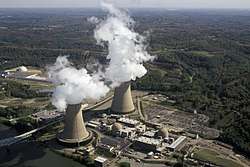Beaver Valley Nuclear Power Station
| Beaver Valley Nuclear Power Station | |
|---|---|
 Aerial photograph of the power plant | |
| Country | United States |
| Location | Shippingport, Beaver County, Pennsylvania |
| Coordinates | 40°37′24″N 80°25′50″W / 40.62333°N 80.43056°WCoordinates: 40°37′24″N 80°25′50″W / 40.62333°N 80.43056°W |
| Status | Operational |
| Construction began |
Unit 1: June 26, 1970 Unit 2: May 3, 1974 |
| Commission date |
Unit 1: October 1, 1976 Unit 2: November 17, 1987 |
| Construction cost | $8.520 billion (2007 USD)[1] |
| Owner(s) |
Unit 1: PPL Corporation Unit 2: Ohio Edison (FirstEnergy) |
| Operator(s) | FirstEnergy Nuclear |
| Nuclear power station | |
| Reactor type | PWR |
| Reactor supplier | Westinghouse |
| Cooling source | Ohio River |
| Cooling towers | 2 × Natural Draft |
| Power generation | |
| Units operational |
1 × 921 MW 1 × 905 MW |
| Make and model | WH 3-loop (DRYSUB) |
| Thermal capacity | 2 × 2900 MWth |
| Nameplate capacity | 1826 MW |
| Capacity factor |
95.73% (2017) 80.25% (lifetime) |
| Annual net output | 15,312 GWh (2017) |
|
Website Beaver Valley | |
Beaver Valley Power Station is a nuclear power plant covering 1,000 acres (400 ha) near Shippingport, Pennsylvania, United States, 34 miles (55 km) roughly northwest of Pittsburgh. The Beaver Valley plant is operated by FirstEnergy Nuclear Operating Corporation.
This plant has two Westinghouse pressurized water reactors.
While the Shippingport Reactor has been decommissioned, Beaver Valley Units 1 and 2 are still licensed and in operation.
FirstEnergy announced that Beaver Valley is expected to close in 2021 without legislative relief or sale to another utility company.[2]
Surrounding population
The Nuclear Regulatory Commission defines two emergency planning zones around nuclear power plants: a plume exposure pathway zone with a radius of 10 miles (16 km), concerned primarily with exposure to, and inhalation of, airborne radioactive contamination, and an ingestion pathway zone of about 50 miles (80 km), concerned primarily with ingestion of food and liquid contaminated by radioactivity.[3]
The 2010 U.S. population within 10 miles (16 km) of Beaver Valley was 114,514, a decrease of 6.6 percent in a decade, according to an analysis of U.S. Census data for msnbc.com. The 2010 U.S. population within 50 miles (80 km) was 3,140,766, a decrease of 3.7 percent since 2000. Cities within 50 miles include Pittsburgh (27 miles upwind of city center).[4]
Seismic risk
The Nuclear Regulatory Commission's estimate of the risk each year of an earthquake intense enough to cause core damage to the reactor at Beaver Valley was Reactor 1: 1 in 20,833; Reactor 2: 1 in 45,455, according to an NRC study published in August 2010.[5][6]
Fessenheim
Beaver Valley 1 was used as the reference design for the French nuclear plant at Fessenheim.[7]
See also
- Shippingport Reactor - Located adjacent to the Beaver Valley Power Station
References
- ↑ "EIA - State Nuclear Profiles". www.eia.gov. Retrieved 3 October 2017.
- ↑ Gough, Paul (March 28, 2018). "FirstEnergy could deactivate Beaver Valley Nuclear Operating Station". BizJournal. Pittsburgh.
- ↑ https://www.nrc.gov/reading-rm/doc-collections/fact-sheets/emerg-plan-prep-nuc-power-bg.html
- ↑ Bill Dedman, Nuclear neighbors: Population rises near US reactors, msnbc.com, April 14, 2011 http://www.msnbc.msn.com/id/42555888/ns/us_news-life/ Accessed May 1, 2011.
- ↑ Bill Dedman, "What are the odds? US nuke plants ranked by quake risk," msnbc.com, March 17, 2011 http://www.msnbc.msn.com/id/42103936/ Accessed April 19, 2011.
- ↑ http://msnbcmedia.msn.com/i/msnbc/Sections/NEWS/quake%20nrc%20risk%20estimates.pdf
- ↑ Thèse, publiée sur internet, de FOASSO Cyrille (Université Lumière Lyon2 - 2003) "Histoire de la sûreté de l'énergie nucléaire civile en France (1945-2000)" Le concept de centrale de référence : assurer les conditions d'un transfert de technologie optimum - "Dans cet apprentissage de la technologie des réacteurs à eau légère, EDF s'appuie sur le concept dit de «centrale de référence», adopté pour suppléer à son manque de connaissances en profondeur de ce type de réacteurs. Le concept de centrale de référence marque une étape fondamentale dans l'opération de transfert de technologie depuis les Etats-Unis vers la France." "pour Fessenheim c'est la centrale de Beaver Valley qui est choisie comme référence"
External links
- "Pennsylvania Nuclear Profile". Energy Information Administration, U.S. Department of Energy (DOE). 2010. Retrieved 2016-11-01.
- "Beaver Valley Power Station". Operating Nuclear Power Reactors. U.S. Nuclear Regulatory Commission (NRC). April 1, 2016. Retrieved 2016-11-01.
